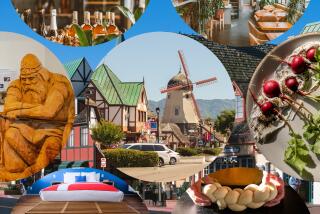Carriage House: Have Buggy, Will Travel
- Share via
Vehicles ranging from horse-drawn phaetons, once driven by the gentry, to wagons and stagecoaches form a collection of vintage conveyances at the Santa Ynez Valley Historical Society’s Parks-Janeway Carriage House near Solvang.
Here in neat rows are buggies, carts, surreys, buckboards and stagecoaches that provided transportation for travelers before such inventive machinists as Ransom Olds and Henry Ford began tinkering with engines that could power a carriage. The collection, considered one of the finest in the West, covers the latter half of the 19th Century and the early years of the 20th.
Keeping Out the Elements
A visitor paused to examine a Wells Fargo & Co. Express stagecoach. The model was open on the sides with curtains that could be rolled down in rainy weather. Because it was light and swift, it was often called a celerity wagon.
“Must have been uncomfortable and cold riding,” the visitor observed.
Waterman L. Ormsby Jr., a correspondent for the New York Herald was a passenger on a similar coach during the first western trip across the continent, riding in John Butterfield’s short-lived Overland Mail stage line that left St. Louis en route to San Francisco Sept. 16, 1858. It was an uncomfortable journey.
Nearing California, Ormsby described in one of his articles that the road had been tortuous and stony, but the driver’s ambition to make good time overcame his caution “and away we went, bumping over the stones at a fearful rate.”
The Carriage House was a gift to the Santa Ynez Historical Society by Betty N. Parks and Elizabeth Bixby Janeway. There are a number of other interesting exhibits in the museum. One room contains a diorama depicting the life of the Chumash Indians who were the original inhabitants of the Santa Ynez Valley. There are displays of the basketry for which they are justifiably famous. Tools, ornaments, ceremonial objects and other artifacts that have been found reflect similarly fine workmanship.
Driving east from Solvang en route to Santa Ynez, you will pass the Santa Ines Mission, which was founded in 1804. By 1816, there were nearly 800 Indians working there. The mission had a stormy history--plagued by an Indian revolt, an earthquake that leveled it in 1812, and an attack by the Argentine privateer Hippolyte Bouchard in 1818.
One room at the Carriage House museum is devoted to pictures and artifacts relating to the history of the mission. Another re-creates the interior of a house of the 1880s including a kitchen complete with a wood-burning stove and antique utensils.
The visitor will discover that the Santa Ynez Valley Historical Society has created a visual chronicle tracing the growth of the region from the era when early settlers came to live here in the 1850s, raising cattle and planting groves of olives, peaches, walnuts, prunes, apples and cherries on the higher ground.
The museum is four miles east of Solvang and two blocks off California 246. At Santa Ynez, look for a service station at Edison Street, turn left and continue to Sagunto Street. Turn right and go one block to the museum. Museum hours are Fridays, Saturdays and Sundays, 1 to 4 p.m. Carriage House hours are Tuesday through Thursday, 10 a.m. to 4 p.m.; Fridays, Saturdays and Sundays, 1 to 4 p.m. Admission is free. Information: (805) 688-7889.
More to Read
Sign up for The Wild
We’ll help you find the best places to hike, bike and run, as well as the perfect silent spots for meditation and yoga.
You may occasionally receive promotional content from the Los Angeles Times.






